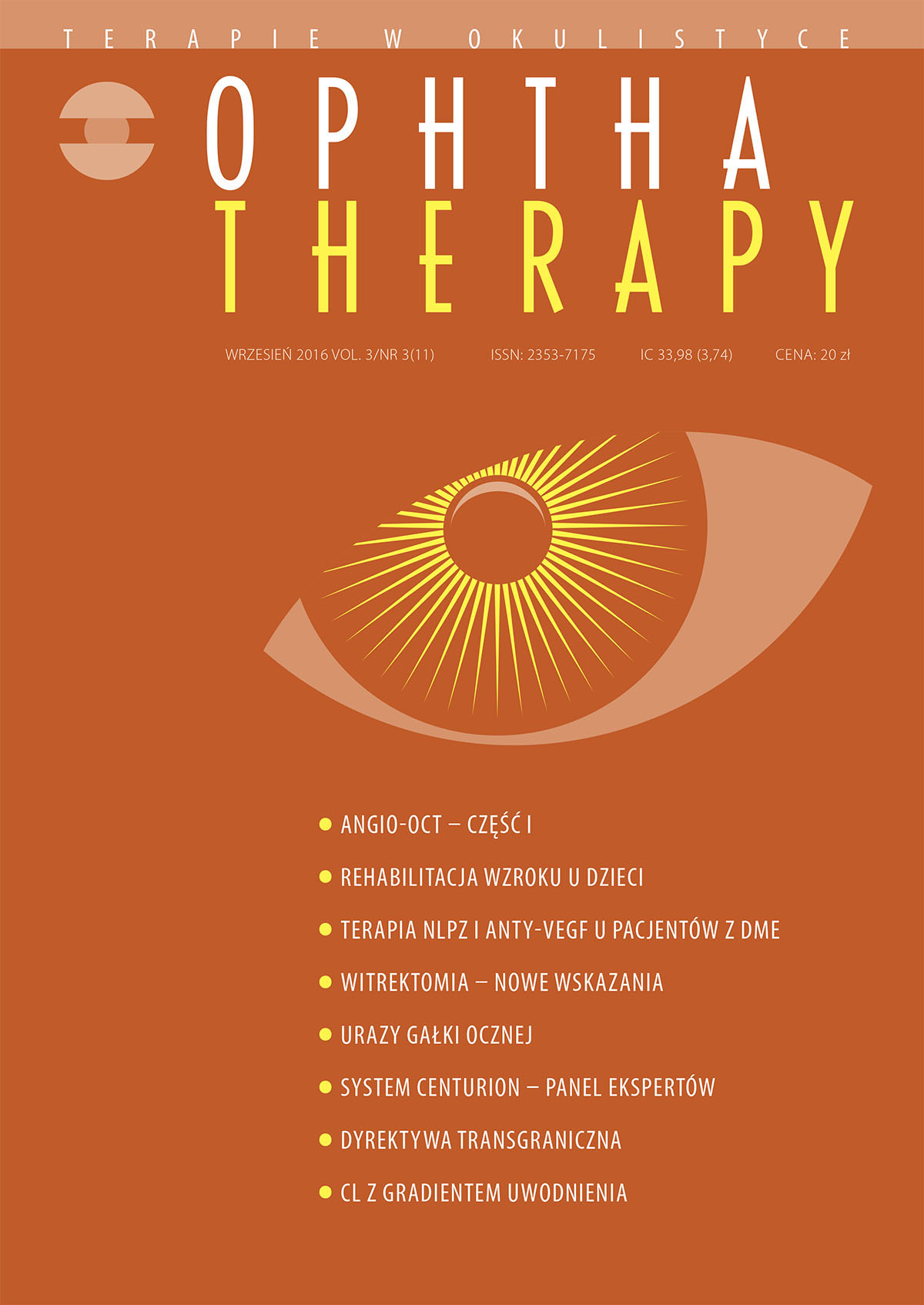Miejscowe zastosowanie niesteroidowych leków przeciwzapalnych w terapii obrzęku plamki w oczach po pars plana witrektomii z endotamponadą olejem silikonowym – opis przypadków
##plugins.themes.bootstrap3.article.main##
Abstrakt
Cel pracy: Ocena wpływu miejscowego podania nepafenaku w postaci kropli do oka na obrzęk centralnej siatkówki.
Materiał i metody: Trzech chorych w wieku średnio 68 lat leczono miejscowo niesteroidowym preparatem przeciwzapalnym 0,1% nepafenaku z powodu obrzęku plamki w oczach po pars plana witrektomii z endotamponadą olejem silikonowym. Ocenie poddano morfologię plamki za pomocą optycznej koherentnej tomografii i funkcję oka na podstawie badania ostrości wzroku na tablicach Snellena.
Wyniki: U wszystkich chorych w obrazie optycznej koherentnej tomografii stwierdzono poprawę morfologii plamki z redukcją centralnej grubości siatkówki, najlepiej skorygowana ostrość wzroku utrzymywała się na tym samym poziomie w okresie obserwacji.
Wniosek: Nasze obserwacje sugerują ograniczony udział ciała szklistego w transporcie wewnątrzgałkowym do tylnego odcinka oka niesteroidowych leków przeciwzapalnych podawanych w postaci kropli ocznych.
Pobrania
##plugins.themes.bootstrap3.article.details##

Utwór dostępny jest na licencji Creative Commons Uznanie autorstwa – Użycie niekomercyjne – Bez utworów zależnych 4.0 Międzynarodowe.
Copyright: © Medical Education sp. z o.o. License allowing third parties to copy and redistribute the material in any medium or format and to remix, transform, and build upon the material, provided the original work is properly cited and states its license.
Address reprint requests to: Medical Education, Marcin Kuźma (marcin.kuzma@mededu.pl)
Bibliografia
2. Hariprasad SM, Callanan D, Gainery S et al. Cystoid and diabetic macular edema treated with nepafenac 0.1%. J Ocul Pharmacol Ther. 2007; 23: 585-90.
3. Singh R, Alpern L, Jaffe GJ et al. Evaluation of nepafenac in prevention of macular edema following cataract surgery in patients with diabetic retinopathy. Clin Ophthalmol. 2012; 6: 1259-69.
4. Wolf EJ, Braunstein A, Shih C et al. Incidence of visually significant pseudophakic macular edema after uneventful phacoemulsification in patients treated with nepafenac. J Cataract Refract Surg. 2007; 33: 1546-9.
5. Walters T, Raizman M, Ernest P et al. In vivo pharmacokinetics and in vitro pharmacodynamics of nepafenac, amfenac, ketorolac, and bromfenac. J Cataract Refract Surg. 2007; 33: 1539-45.
6. Gamache A, Graff G, Brady MT et al. Nepafenac, a unique nonsteroidal prodrug with potential utility in the treatment of trauma-induced ocular inflammation: I. Assessment of anti-inflammatory efficacy. Inflammation. 2000; 24: 357-70.
7. Flach AJ. Cyclo-oxygenase inhibitors in ophthalmology. Surv Ophthalmol. 1992; 36: 259-84.
8. Smyth EM, Fitzgerald GA. The eicosanoids: prostaglandins, thromboxanes, leukotrienes & related compounds. In: Katzung B. (ed). Basic and Clinical Pharmacology. McGraw Hill, New York 2007: 293-308.
9. Kapin MA, Yanni JM, Brady MT et al. Inflammation-mediated retinal edema in the rabbit is inhibited by topical nepafenac. Inflammation. 2003; 27: 281-91.
10. Ke TL, Graff G, Spellman JM et al. Nepafenac, a unique nonsteroidal prodrug with potential utility in the treatment of trauma-induced ocular inflammation: II. In vitro bioactivation and permeation of external ocular barriers. Inflammation. 2000; 24: 371-84.
11. Kulkarni PS, Srinivasan BD. Cyclooxygenase and lipoxygenase pathways in anterior uvea and conjunctiva. Prog Clin Biol Res. 1989; 312: 39-52.
12. Radi ZA, Render JA. The pathophysiologic role of cyclooxygenases in the eye. J Ocul Pharmacol Ther. 2008; 24: 141-51.
13. Lindstrom R, Kim T. Ocular permeation and inhibition of retinal inflammation: an examination of data and expert opinion on the clinical utility of nepafenac. Curr Med Res Opin. 2006; 22: 397-404.
14. Bucolo C, Marrazzo G, Platania CBM et al. Effects of topical indomethacin, bromfenac and nepafenac on lipopolysaccharide-induced ocular inflammation. J Pharm Pharmacol. 2014; 66: 954-60.
15. Koevary SB. Pharmacokinetics of topical ocular drug delivery: potential uses for the treatment of diseases of the posterior segment and beyond. Curr Drug Metab. 2003; 4: 213-22.
16. Maurice DM, Mishima S. Ocular pharmacokinetics. In: Sears ML (ed). Pharmacology of the Eye: Handbook of Experimental Pharmacology. Springer-Verlag, Berlin 1986: 19-116.
17. Maurice DM. Drug delivery to the posterior segment from drops. Surv Ophthamol. 2002; 47: 41-52.
18. Hughes PM, Olejnik O, Chang-Lin JE et al. Topical and systemic drug delivery to the posterior segments. Adv Drug Deliv Rev. 2005; 57: 2010-32.
19. Chastain JE, Sanders ME, Curtis MA et al. Distribution of topical ocular nepafenac and its active metabolite amfenac to the posterior segment of the eye. Exp Eye Res. 2016; 145: 58-67.
20. Nardi M, Lobo C, Bereczki A et al. Analgesic and anti-inflammatory effectiveness of nepafenac 0.1% for cataract surgery Clin Ophthalmol. 2007; 1: 527-33.
21. Modi SS, Lehmann RP, Walters TR et al. Once-daily nepafenac ophthalmic suspension 0.3% to prevent and treat ocular inflammation and pain after cataract surgery: phase 3 study. J Cataract Refract Surg. 2014; 40: 203-11.

